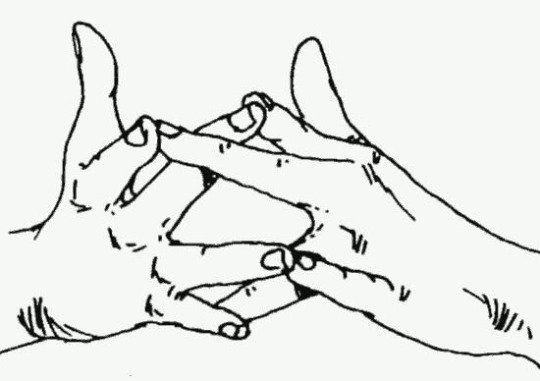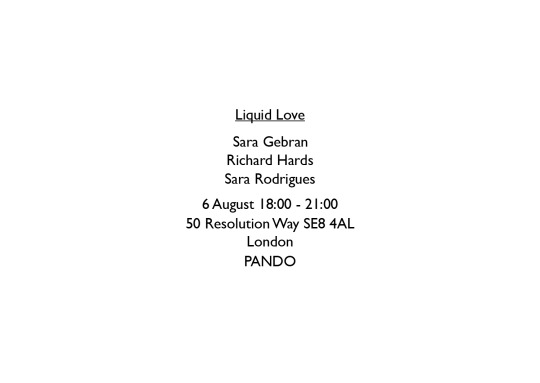Text
Three Lines
18 Oct -22 Nov 2017
Guillermina Caicoya Art Projects, Oviedo, Spain
Guillermina Caicoya Art Projects tiene el placer de presentar la primera exposición individual en España del artista británico Tom Benson.
La exposición presenta obras en tres tipos de medio: dibujo, pintura y fotografía, que se centran en elementos concretos como escala, luz y color.
Three Lines incluye una secuencia de dibujos realizados a lápiz de color, cada uno de los cuales consiste de tres líneas cuyas longitudes y relaciones entre sí están determinadas por las dimensiones del papel - la longitud total de las líneas es igual a la altura o al ancho del papel. Mediante sus parámetros formales, estos trabajos exploran nociones más amplias del dibujo y de la relación entre línea, superficie y espacio. Factores como el grosor de la línea están determinados por la naturaleza impredecible de la tiza al desmenuzarse; el artista incluye lo inesperado dentro de la estructura de las obras, de igual forma utilizando errores que se producen durante el proceso de dibujo para hacer cambios sutiles en la composición.
La pintura Óxido 1 (red), esta compuesta por tres elementos de color que cuelgan sobre puntas colocadas en un panel de rojo óxido, creando una serie de tensiones; entre luz y sombra, entre la distinción y la fusión de los elementos de color con el fondo, y entre el orden y la ubicación de las piezas. El entramado de perforaciones sobre el soporte permite que la obra se instale de manera diferente cada vez que se expone, respondiendo en cada instancia al contexto en el que se cuelga. Lejos de ser un objeto estático, la cuadrícula actúa como una estructura que sirve para expandir las posibilidades de composición, y dar lugar a juegos entre formas, sombras y colores.
El trabajo que cierra la exposición, Someone like you (gray), es una serie de fotografías en blanco y negro de la cabeza de una mujer. La obra registra el cambio secuencial de un estado interno, contemplativo, a uno externo, gesticulando hacia una mirada, el que mira y la exposición.
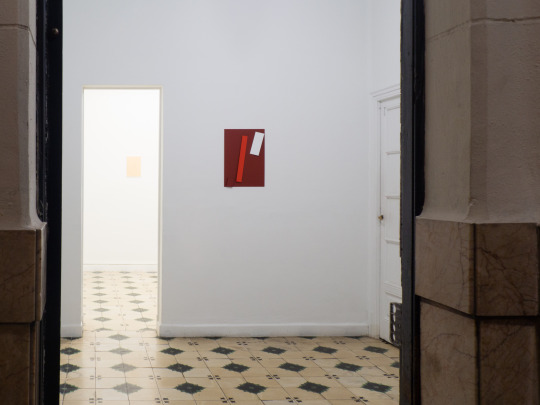
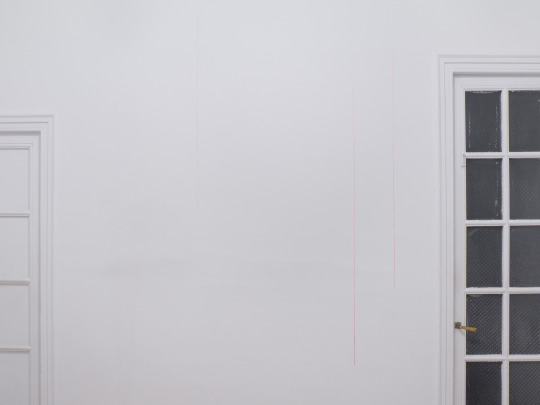

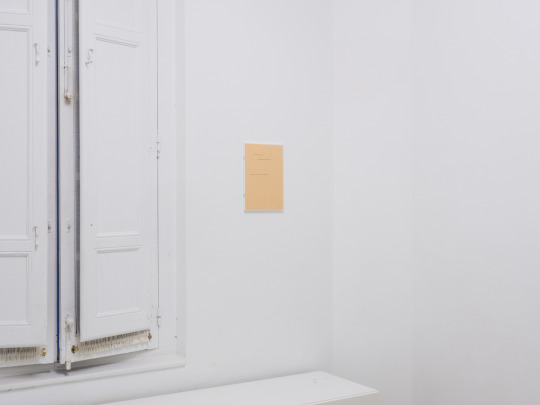
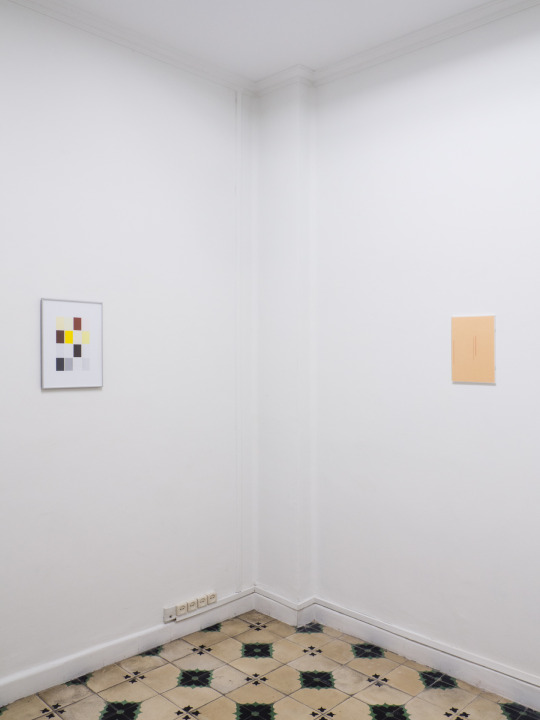
1 note
·
View note
Text
Liquid Love
6th August, 18:00–21:00
PANDO.EnclaveLab 50 Resolution Way, SE8 4AL London
Sara Gebran
Richard Hards
Sara Rodrigues
The title of this event makes reference to the display situation at Enclave in Deptford, which incorporates three more elements this week, brought by artists Sara Gerbran, Richard Hards and Sara Rodrigues in the form of transparent matter.
Liquid Love is an exercise on how a proxy can impersonate the shape of a sound; transferring information into audio; engaging with networks and knowledge distribution; being interference in the system; transforming consciousness by tuning the body via listening.
The intent here is, in part, to resituate the dialogue from the page, the stream, the encoding; from the listener, the type of listening, from the ear, from the mind, and indeed from the individual human; to the air. Air is the material for the composition of a commons. Audio is an ephemeral social architecture made of air.
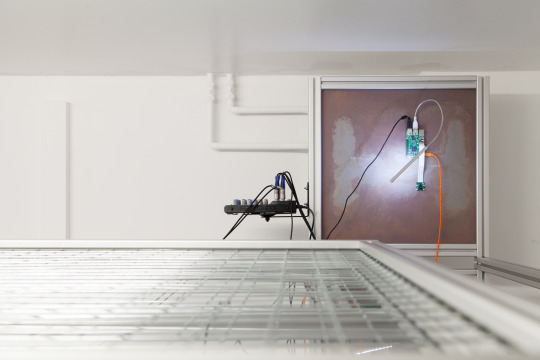
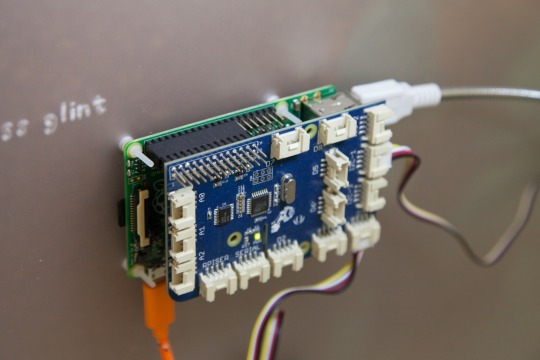

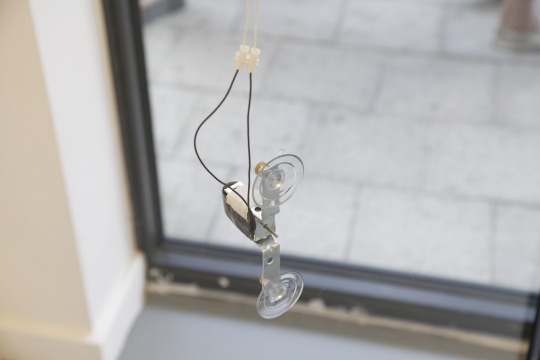
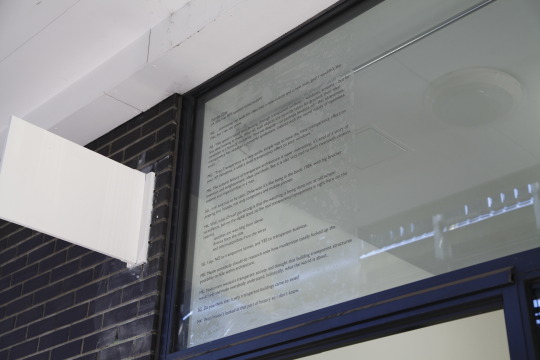
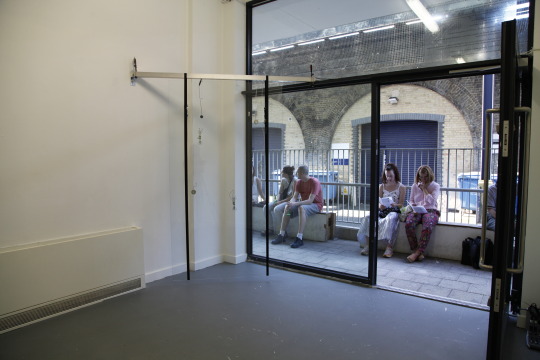
1 note
·
View note
Text
Tender Buttons
15-17 septiembre 2017, Salón, Madrid
Una exposición con obras de Fran Meana y Madalina Zaharia, comisariada por Cristina Ramos y Alfredo Aracil
Act so that there is no use in a center - Gertrude Stein, Tender Buttons
En el verano de 1912, durante unas vacaciones en España, Gertrude Stein comenzó a escribir una serie de poemas cortos sobre objetos discretos y pequeños eventos. Detalles en apariencia insignificantes, en tanto que cotidianos y exiguos, parte de una rutina a menudo invisible, como la que acontece cuando las vacaciones se escurren entre compras, paseos, comidas y charlas. Aunque la intención de elaborar poemas a partir de tales motivos no fue algo especialmente radical, es con la publicación de Tender Buttons que Stein desarrolla un tipo de escritura no-normativa donde las palabras y las cosas se quiebran como moléculas flotando en el espacio, en el vacío repleto de una gramática descosida.
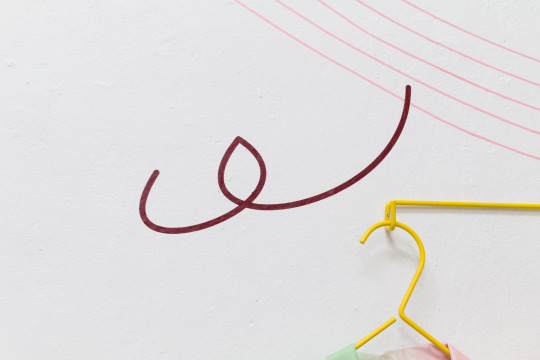
Dividido en tres secciones - Objetos, Comida y Habitaciones - el libro nos ha servido como vehículo para plantear otros modos de hacer en la práctica artística y curatorial. Ejercicio expositivo, aunque también experimento de traducción conjunta y pregunta por la afectividad que atesora el campo del trabajo artístico, este proyecto es fruto de una intensa discusión a cuatro bandas. Una conversación intermitente que data de principios de 2017, cuando empezamos a pensar de qué manera el método de Stein anticipa una forma de sensibilidad micro, y cómo se pueden establecer vínculos subjetivos con el mundo sin pasar por los modelos y las formas dominantes.
Escalas, patrones, un tipo de geometría amorosa que nace del reflejo del cuerpo proyectado en la mente o cómo un pequeño gesto puede desencadenar otro más grande. Y cómo no, la influencia del cubismo en el hacer de Stein. Todos estos temas han aparecido en nuestra investigación en común. Aunque quizás uno de los conceptos clave, sobre todo para abordar la propuesta de Fran Meana, ha sido la mecanización de la mirada. El modernismo produce una serie de operaciones de corte que no sólo revelan nuestra manera de integrar el mundo, la mirada y el lenguaje como algo construido, sistemático y repetitivo, sino como una fuerza maleable que puede ser puesta en circulación con otras intenciones. Por medio de una fan-fiction no autorizada Fran Meana revisa los distintos modos de producción industrial y social de la fábrica de Sargadelos desde su nacimiento a principios del siglo XX hasta la actualidad. Una operación que se apoya en las posibilidades de la tecnologías de fabricación digital para desarrollar ejercicios de recombinación material y formal inspirados en la inusual gramática de Stein.

Trama especulativa, al menos en su primera fase, para un proyecto que aglutina distintos intereses bajo un ritmo de incesantes transformaciones de soporte y registro. Pero situado todo el tiempo en la distintiva arquitectura de Salón, tanto en su diseño espacial - sus puertas, sus paredes y sus suelos - como en aquello que hace único a un lugar para exponer que es, de hecho, una casa para todos aquellos que lo visitan. De nuevo, Stein resuena en nuestro intento de construir un espacio para vivir dentro de otro espacio ya habitado.
Reunidos en la fragmentación que propone el libro, finalmente, hemos armado un proyecto que antepone la idea de “variación” a la noción de “tema”. Decisión a posteriori que se fundamenta en cómo nos ha afectado el proceso de lectura durante estos meses. Precisamente las obras que Madalina Zaharia presenta parten de la idea del leer como labor. Un proceso que también pasa por el cuerpo, donde comisario y artista funcionan como sinónimos. El esquema formal para su performance nace, así, de dos lecturas distintas de un mismo capítulo del libro. Por un lado el texto subrayado y por otro el que no lo está. Ambas partes tratadas con los elementos intrínsecos del acto de leer: entonación y ritmo. De igual modo, Zaharia ha traducido y descrito visualmente la colaboración entre nosotros disponiendo varios elementos en un diagrama que ilustra el proceso de interacción. Aunque de una forma no literal, oscurecido por formas abstractas y por la presencia de un misterioso cuadro que bien podría formar parte de un escenario de novela modernista.
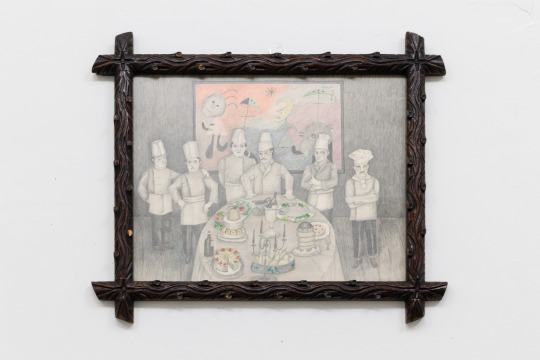
Artista desconocido, ‘Seis cocineros y un Miro’, 1975, Fundación Richter
El ejercicio de lectura comparada que hemos hecho los curadores, traduciendo por separado del inglés a español y luego de vuelta al idioma original para producir aberraciones y sin sentidos que alterasen el sentido del texto, sirve para subrayar cómo hemos concebido la relación entre obras y artistas en este proyecto: no desde la flexibilidad en tanto que límite o marcador, sino como una invitación a hacer y deshacer, donde la imaginación opera como una fuerza plástica y contagiosa que permite adquirir un sinfín de cuerpos y materialidades.
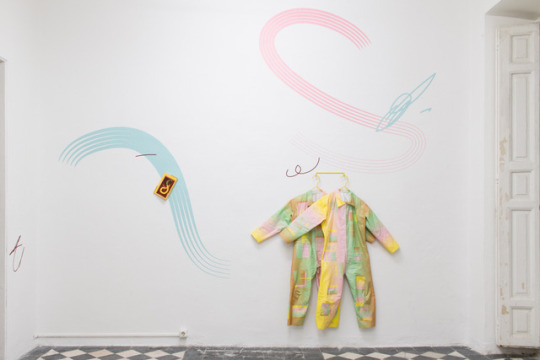
Madalina Zaharia, Tender Buttons, 2017. Vinilo, libro serigrafiado, piezas metálicas y monos de trabajo impresos digitalmente

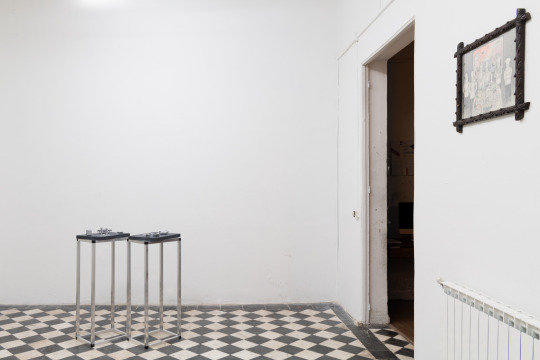

Fran Meana, ‘SRGDLS’, 2017. Plástico PLA impreso, plástico PA moldeado y aluminio
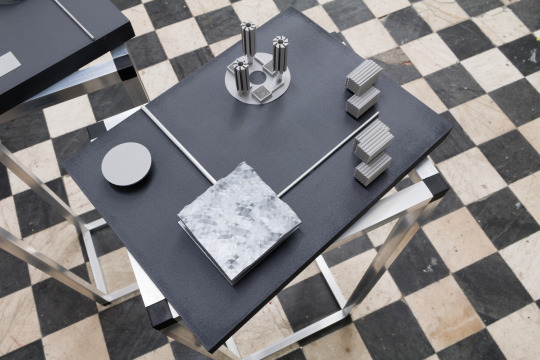
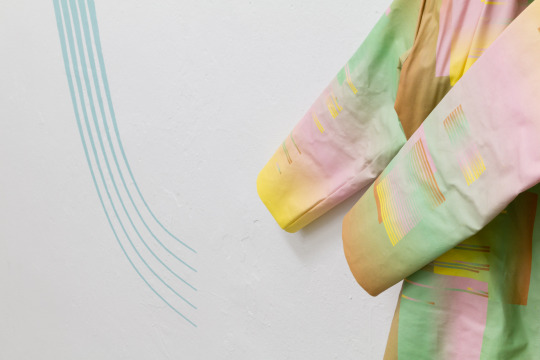
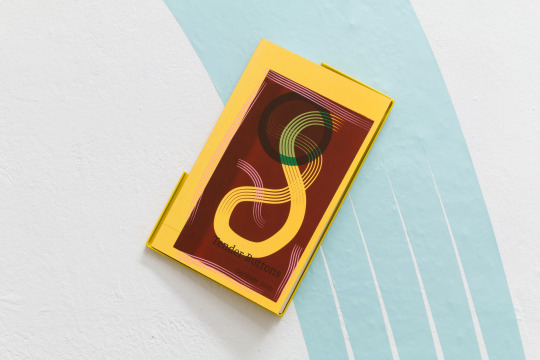
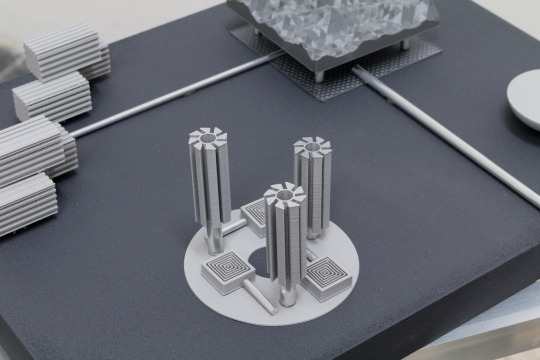

Póster de la exposición diseñado por Christian Lübbert y Cristina Ramos. Impreso en Raum Press, edición de 100 copias


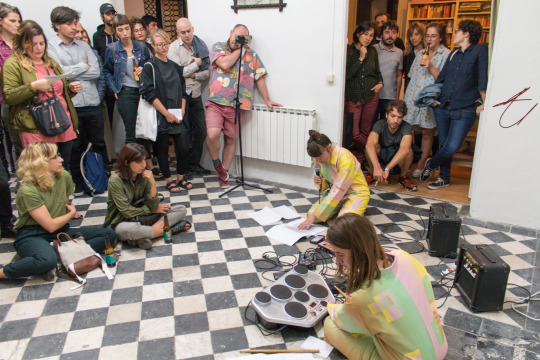
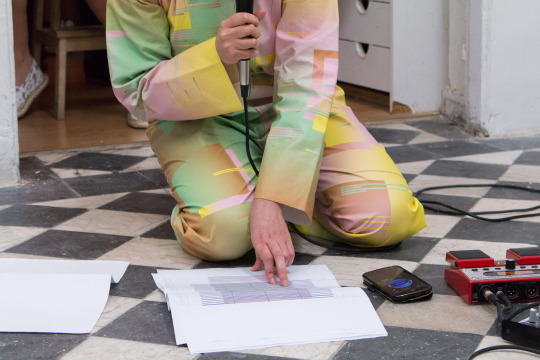

0 notes
Photo
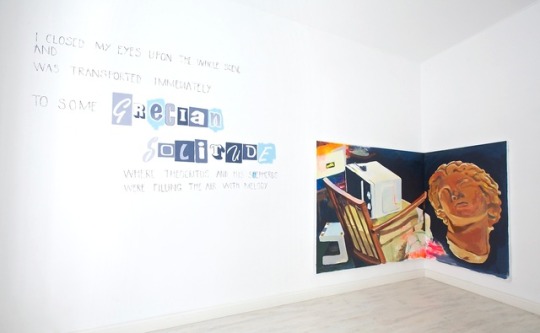
A Grecian Solitude
An exhibition of works by Tomas Pizá, curated by Cristina Ramos /// 1 April - 20 Mayo 2017, Addaya Centre d’art Contemporani, Mallorca
...
We do not know if Antiquity has existed, but at least we have dreamed it. Federico Fellini
The starting point of the paintings presented in A grecian solitude is an archive generated during the trip that Tomas Pizá did following the traces of the British William Beckford after his European Grand Tour two hundred years ago.
During the journey from Belgium to Italy, Pizá was collecting a series of ‘souvenirs’ including photographs, postcards, and innumerable anecdotes which, together with Beckford's own book published in 1783, formed the germ of a visual diary through which Pizá manipulates and reinterprets the ruins of history from a contemporary perspective.
Grand Tour is the name given to the European trip that young aristocrats took as part of their education in the seventeenth and eighteenth centuries. Its value laid in the knowledge gained from the cultural legacy of classical Antiquity and the Renaissance. The trip provided the unique opportunity to visit monuments and see works of art, in a time long before to the reproduction of images. The Grand Tour would be one of the great engines of cultural travel and perhaps, of what we consider today as tourism. In the same way, a great multitude of travel literature were produced as a result of this journey, of which the book Dreams, waking thoughts and incidents by Beckford stands out for being not only an epistolary, but also a descriptive composition of fantastic and surreal nature.
Some quotations from the book have been included in a short publication made for the exhibition by the artist in collaboration with the curator, which includes compositions by Pizá from its archive of postcards, and a curatorial text on some notions of the exhibition.
Pizá delves into the narrative of Beckford to conceive a set of images whose ideological context navigates around the idea of the Mediterranean, the search for identity and the tension of the poetic in mass culture. Formally, the scenes of the paintings are created by juxtaposing visual fragments from the archive, for which the first translation of the image is into collage, to be worked afterwards with the language of painting. The final image maintains an unreal element in its figuration since the composition is not articulated following faithfully the architecture of reality.
The paintings are deeply rooted in history, each brushstroke of oil paint containing several layers of meaning, filled with iconographic, literary, and pictorial references. In this line, we find a series of works with small format Worship my ribs at Florence, my skull at Bologna, Sienna and Rome, whose images come from the Fontanelle Cemetery in Naples, an ancient necropolis that keeps the skeletal remains of those who were too poor to pay for a proper burial. These works establish a poetic point between the transience of the life and the end of the trip, since it was in Naples where both, Pizá and Beckford, returned to the geography of their islands.
Pizá’s stylistic references are varied, from the American painter Eric Fischl in the simulation of the real space, to the warm pop of the English David Hockney in the treatment of the light, passing through Ronald Kitaj and the subject of the exile, of the journey as longing for desires.
Definitely Tomas Pizá’s trip has been one over time, as the Europe that William Beckford portrays is a classic in itself, a book that never ends saying what it has to say. Permanent literature, as Schopenhauer would say.
It is through painting that Pizá associates this eternal return, the transience of the old to the modern, from the repetitive to the archaic tradition. And it is precisely in this painted relationship where the new is added to the old, without ever completely erasing it, but transfiguring it incessantly.
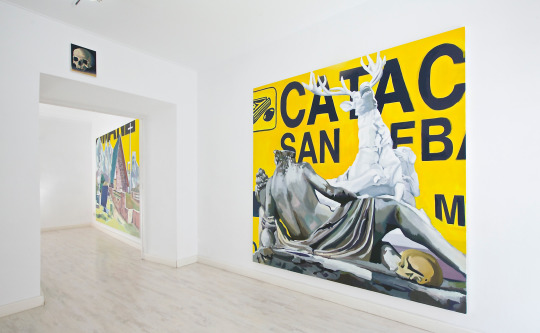
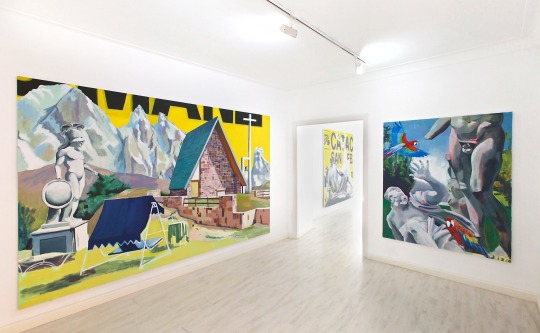
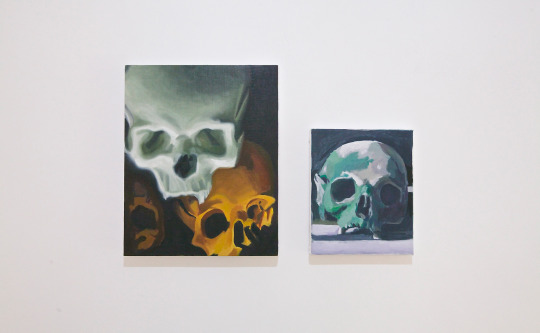
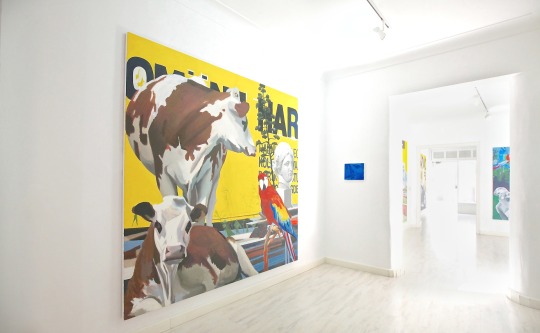
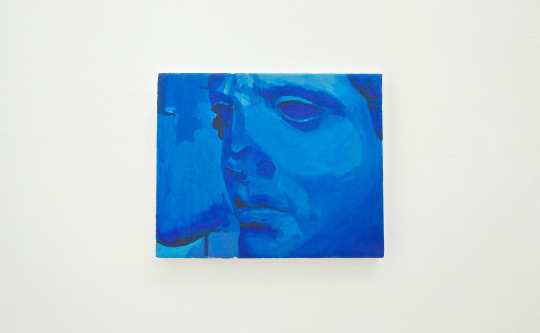

0 notes
Text
I wrote a review of Spanish artist duo Cabello/Carceler retrospective exhibition at CA2M for This is Tomorrow. You can read it here and here in an expanded version:
...
Cabello/Carceller: Draft for an Untitled Exhibition (Chapter II) /// Centro de Arte Dos de Mayo, Madrid 20 January - 7 May 2017
A retrospective is defined as an exhibition that chronologically presents the works of an artist to show their artistic trajectory. Yet the title of Cabello/Carceller’s survey show, ‘Draft for an Untitled Exhibition (Chapter II)’, invites visitors to reject traditional notions of artistic practice and exhibition making straight from the beginning.
Helena Cabello and Ana Carceller, who began collaborating in 1992, present an artistic and critical approach to the discourse surrounding the representation of gender, sexuality, minorities and the role of institutions within the context of a late-capitalist society.
The exhibition rooms at Centro de Arte Dos de Mayo juxtapose works – mostly video installations and photography – from different periods, to reinstate the temporal complexity of life experience beyond the idea of linear progress. In the first room, a time line of the artists’ career is spliced with socio-political facts related to the status of the queer body. The opening entry dates from 1586, ‘the Vicar of Madrid requests a genital examination of Eleno/Elena de Céspedes, hermaphrodite’, while a more recent statistic reminds visitors that homosexuality is still illegal in a third of countries. By integrating personal experience with political history, a different relationship between body and time is proposed.
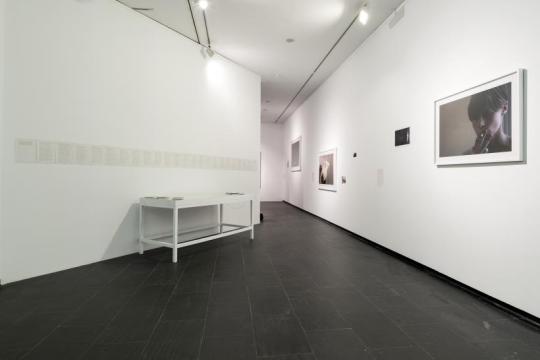
Cabello/Carceller’s working methods include the use of fiction, the play of representation and the inclusion of untrained actors in their videos to dismantle stereotypes, uncovering divergences with conventional values and facilitating alternative narratives. ‘The State of the Art, a performative essay’, was both filmed and exhibited in the Spanish Pavilion at the 2015 Venice Biennial. A migrant woman encounters three other fictional characters in the halls of the pavilion, all of whom are auditioning for employment, a recurring experience for much of the Spanish population. The characters are of different social statuses but all of them engage in some form of sexual dissidence. The film, which borrows feminist, queer and Brechtian aesthetics from experimental cinema, asks how we can resist in a capitalist system that praises extreme competition and economic value.
Judith Butler’s argument that gender is performative provides an important framework for contextualising the artists’ work. The notion that a stable gender identity is an illusion can be seen in ‘Archive: Drag Models’, a series of photographs in which women present themselves as male characters from films – those played by the likes of Marlon Brando, Brad Pitt and James Dean. The photos – conceived by Cabello/Carceller in collaboration with their models – are displayed alongside the iconic film stills they reference, radicalising history by the means of fictional narrative while illustrating the codes of gender.

Cabello/Carceller’s narratives also question physical spaces marked for the creation of genre. For instance, ‘Some Place’ is a series of photographs depicting clubs once they have closed: emptied of people, action performed. I am writing these words back in London, in a cafe opposite the glowing neon of Dalston Superstore, a venue where LGBTQ party-goers and drag artists dance each weekend with no discrimination or judgement. I wonder if a future in which people are never defined by their gender or sexuality is possible, considering the weight of history we are carrying in our contemporary bones.
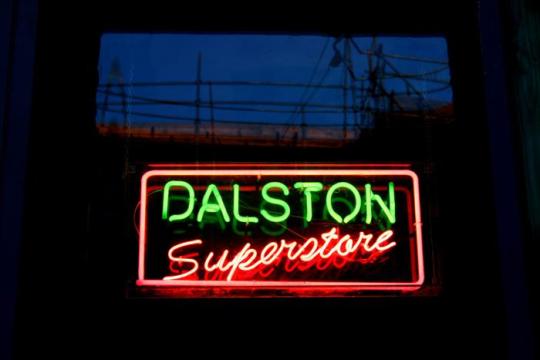
By performing subversive actions and troubling the categories of hegemonic systems, Cabello and Carceller offer hope that, one day, transformative politics would emerge.

0 notes
Text
En octubre de 2016 escribí un texto sobre las obras que el artista Fernando Martín Godoy expuso en la Mustang Art Gallery en Alicante, España, bajo el titulo Números Primos.
...
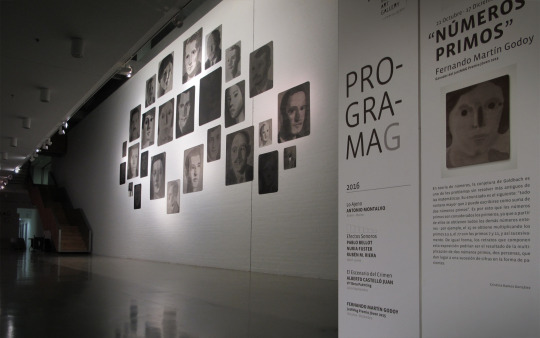

El trato de Golbach
En teoría de números, la conjetura de Goldbach es uno de los problemas sin resolver más antiguos de las matemáticas. Su enunciado es el siguiente: “todo número mayor que 2 puede escribirse como suma de dos números primos”. Es por esto que los números primos son considerados los primeros, ya que a partir de ellos se obtienen todos los demás números enteros – por ejemplo, el 15 se obtiene multiplicando los primos 3 y 5, el 77 con los primos 7 y 11, y así sucesivamente. De igual forma, los retratos que componen esta exposición podrían ser el resultado de la multiplicación de dos números primos, dos personas, que dan lugar a una sucesión de cifras en la forma de parientes.
Familiares que, si bien no comparten parentesco en el estricto sentido de la palabra, son reunidos en la misma línea de sangre de la mano de Fernando Martín Godoy. Siendo fiel al esquema de su propio árbol genealógico, Martín Godoy utiliza material apócrifo como punto de partida en la composición de la imaginería de la exposición. A través de la utilización de recortes y fotografías anónimas, y su presentación como la familia del artista, la exposición establece una reflexión sobre el yo y la identidad colectiva. Mediante la creación de esta ficción biográfica, las cuestiones del yo y la identidad quedan en entredicho, ya que las obras se alejan de la representación-semejanza del parecido físico o el carácter del retratado.
En “Números Primos” Godoy se aleja de su tradición retratista más figurativa, dando un rodeo para dar precisamente en la diana, en la esencia de un ser humano concreto e individualizado pero expuesto en un contexto común, familiar y reconocible. A través de esta tensión establecida entre el sujeto colectivo y el individual, el artista nos hace reflexionar sobre lo que una narrativa familiar canónica representa habitualmente y sobre lo que no representa. En este escenario, el individuo y su familia, actores principales del espacio privado, juegan a representar una ‘humanidad compartida’, puesto que el material empleado ha sido tomado de muy diversas fuentes; tal vez el retrato de la madre de Fernando provenga de la imagen de una peruana, o su tío abuelo de Moscú… Al fin y al cabo, todos contenemos el mismo genoma y son las diferencias de clase, alimentación, localización geográfica, etc. lo que nos hace ser tan diversos unos de otros. La exposición ofrece un retrato de la humanidad, no solo poniendo énfasis en las diferencias de los hombres, sino también en su pertenencia a una familia. Concluyendo que la familia también es, al igual que el individuo y la sociedad, una conformación jerárquica en la que se inscriben las estructuras de poder.
El retrato es una constante en el trabajo tanto pictórico como objetual de Fernando Martín Godoy, pero el proyecto “Números Primos” es el más personal del artista hasta la fecha, estableciendo una semejanza directa entre su vida privada y el espacio expositivo. Aun así, el hecho de que éste árbol genealógico no esté compuesto por los retratos reales de su familia, hace que el artista se aleje de crear una nota biográfica cargada de sentimentalidad y sugiera más bien un afecto en el espectador, que inventará sus propias narrativas familiares más allá de la mera contemplación de las obras. Formalmente, las obras reducen la brecha entre las tradiciones de la abstracción y de la figuración mediante el uso de estrategias de ambos estilos. Por ejemplo, la elección de la técnica como es tinta china sobre papel intensifica las formas y la yuxtaposición de veladuras, mientras que la cuidada preferencia de cuáles son las formas escogidas para representar los rasgos faciales, balancean el aspecto figurativo.
Cada retrato es un elemento que propicia la construcción de una nueva identidad del sujeto colectivo-individual; es una práctica de liberación que construye su propia forma identitaria, que no puede pensarse solo en términos individuales. Al mismo tiempo, el artista es incapaz de representar a la familia sin que en cierta medida se represente también a sí mismo. Individuo y colectivo se significan por lo tanto inseparables.
0 notes
Text
I was invited to talk about curation at the University of Arts in Oviedo from the perspective of an independent curator, and I took the chance to show some interesting approaches in exhibition-making:
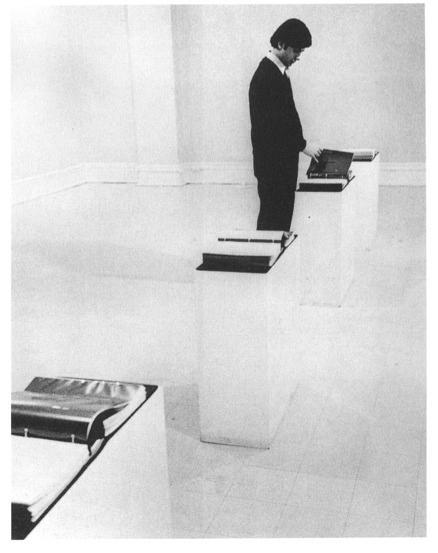
Mel Bochner, Working Drawings and Other Visible Things on Paper Not Necessarily Meant to Be Viewed as Art, 1966. Four identical loose-leaf notebooks, each with 100 xerox copies of studio notes, working drawings, and diagrams collected and xeroxed by the artist, displayed on four sculpture stands.
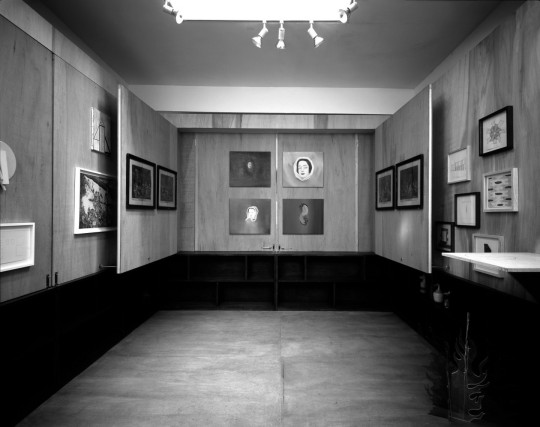
Goshka Macuga, Picture Room, Gasworks, London, 2003. The project involved the recreation of a section of Sir John Soane's Museum at 13 Lincoln's Inn Fields, London, the famous Picture Room, inside the gallery space. Within this facsimile, Macuga curated an exhibition of artworks from thirty collaborating artists.

0 notes
Photo

/ / / Some words I wrote in tribute to John Berger about perspective and perception on the occasion of ‘Parallax Scrolling’, an exhibition at Breese Little in London.

0 notes
Text
Uep
Figures of speech #4 Allegory /// Opening Friday 24 June 20.00h 25 June – 29 July 2016, Addaya Centre d’art Contemporani, Mallorca
Tom Benson, David Price, Hannah Lees, Fay Nicolson, Michael Lawton. Curated by Cristina Ramos
...
- On Thursday 11th March 2009 I arrived at the Bonneville Salt Flats in Utah with the Honda CBR 100 that the team had lent me in New York, one of the best from the family. The salty desert spread out under the midday sun. Points of light on the ground, tiny grains of salt as bright as the layer of metallic paint on the motorcycle.
How many constellations could I draw by joining the different grains of salt? How many combinations would be possible, how many recognizable figures could I find? I don’t give myself to calculations and I think of the test. Although in fact it would be more logical to define it as a route more than a test, a line drawn between A and B.
There is no way to escape the logic of the traveller – persisting in indeterminate places, not getting carried away by an idea but building my own, my own idea of what a trace might be - the moment of a gesture that is printed somewhere, somehow. Maybe if I manage to exceed 300 mph I will arrive at some conclusions. Thinking of prints I then check the status of my camera, an Instamatic 400. There are four shots left in the black and white Kodak 126 film - I have no more rolls and according to Wikipedia, they stopped manufacturing them in 2007. [...]
As I take photographs of the tire tracks in the salt I think that the action I’m executing is like photographing a photograph - recording an image that already exists but that is not a document in the rationalistic sense of the word 'to document'; it is more like the image of a memory –.
The works included in ‘Uep’ are presented as allegories of traces, marks that make a reference to a particular moment. This moment can be an allusion to a place, a gesture, a movement, an earlier work, a coincidence or a word. The artists take a figurative approach to memory, drawing the abstract, trying to make visible what is only conceptual. The title itself is also an allegory, a reference to the geographical location of the gallery, and reproduces sounds of reality through the written word.
‘Uep’ is the fourth exhibition in the 'Figures of speech' series devised by Cristina Ramos. The project aims to use specific literary devices to contextualise its exhibitions and it was started in London in 2015.
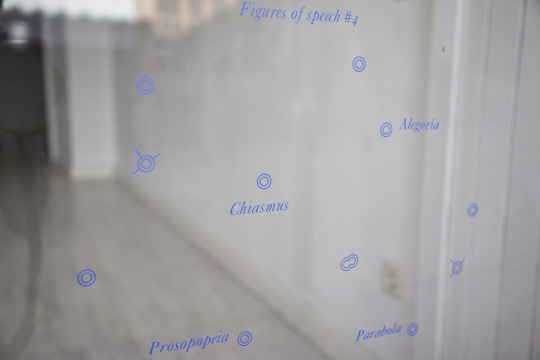
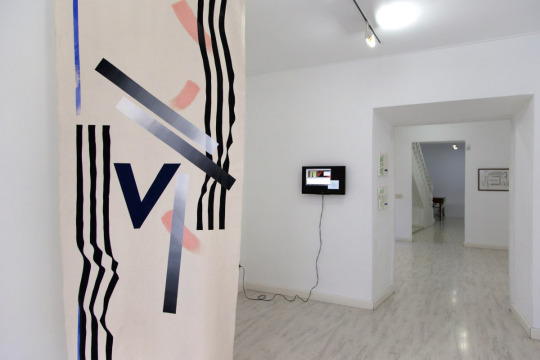
Fay Nicolson, O(V)ER, 2015. Acrílico y serigrafía sobre lienzo

David Price, Floor Story (other people’s wardrobes) (the history book on the shelf), 2016. Puzzle

Left to right: David Price, What sort of film pt.2 - Aspects of the Past, subtitulado, i parlat sobre (català central), 2015-2016. Digital video, and Michael Lawton, Marcel and Stéphane, 2016. Óleo sobre lienzo
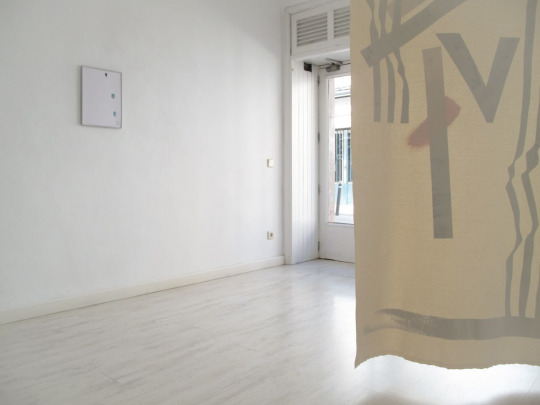
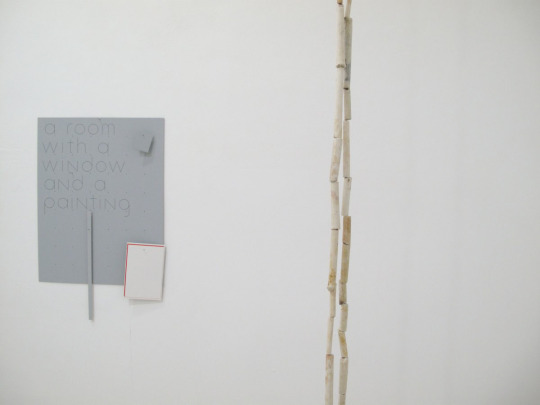
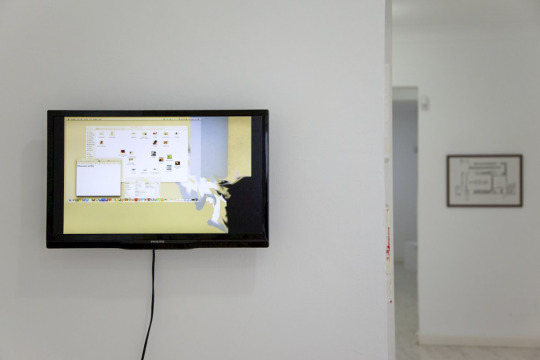
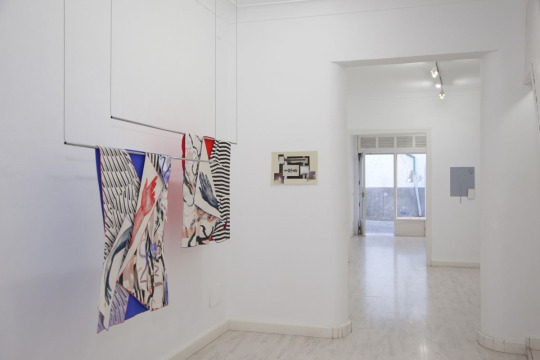
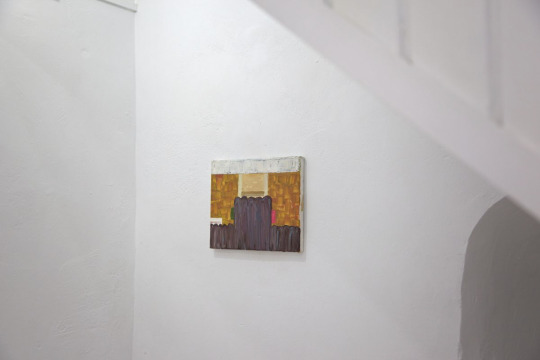
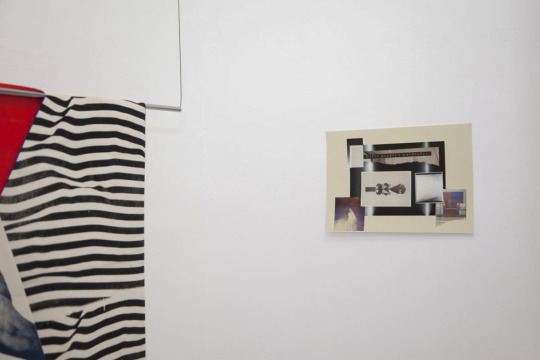
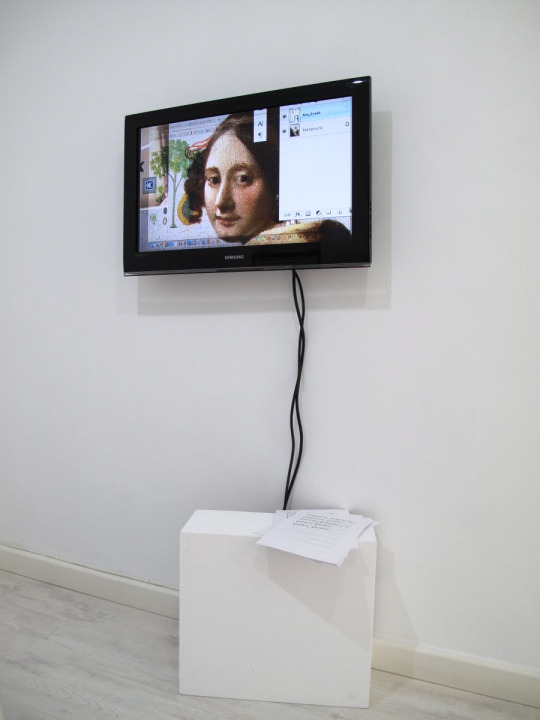

Documented by Marta Pujades / Graphic design of the gallery floor by Patricia Vega
0 notes
Photo
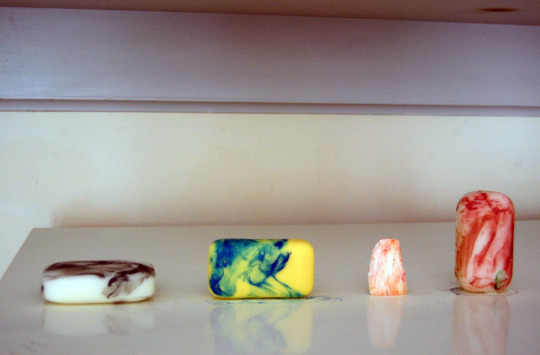
Work by Kate Owens, Towards Zero (13, 16, 7, 19), 2013-2014. Exhibited in A Way Home, the first exhibition that I co-curated with Sara Rodrigues for The LivingRoom .
https://www.youtube.com/watch?v=auAlZTOCvnE
0 notes
Text
A few months ago, some of the participants at ‘John in a Cage’ and I went to Resonance FM to speak about the project with William English. You can listen to the full programme here...
https://www.mixcloud.com/Resonance/wavelength-29th-january-2016/
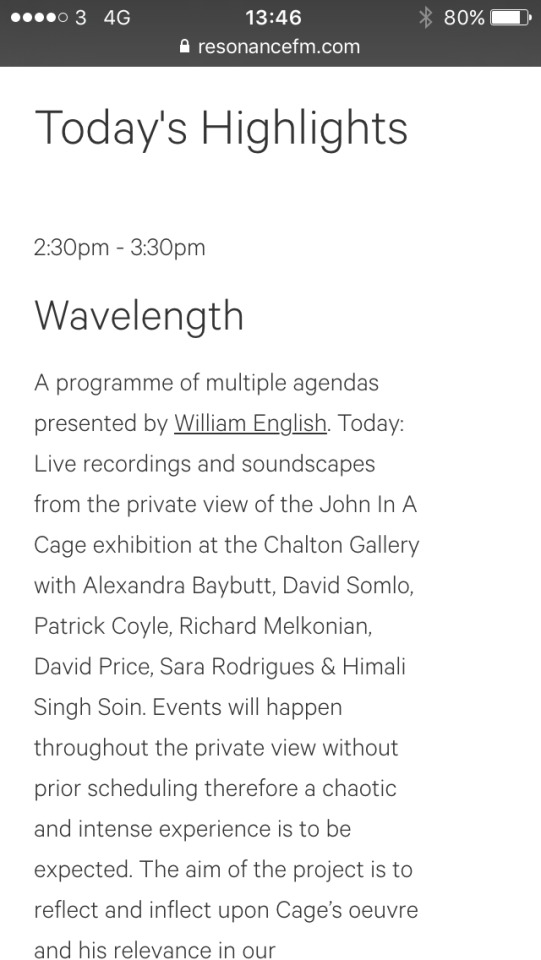
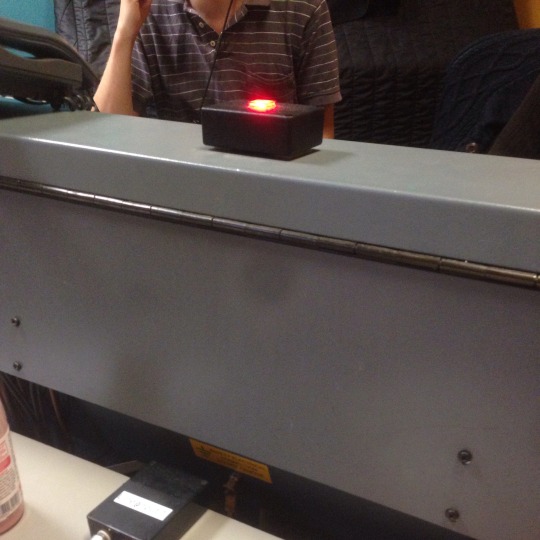
0 notes
Text
For the last exhibition I curated at Window Space Gallery (in November 2015), I invited artist Eva Fabregas to device a site-specific intervention for which she came up with How are you feeling today?
In her work, Fàbregas explores the secret life of things and everyday objects, approaching them as social actors through which our feelings, affects and desires circulate.
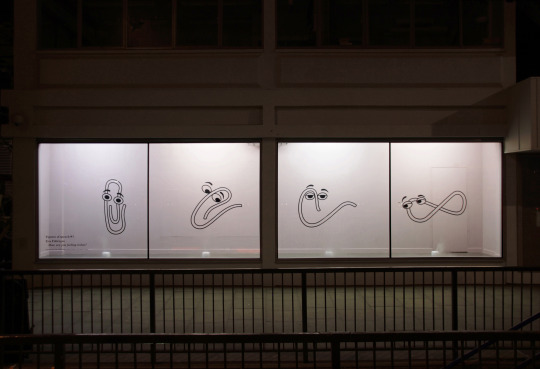
This exhibition was the first of a series of works in which the artist brings back to life Clippit, the infamous Microsoft Office assistant created by the multinational corporation in 1996. Popularly known as ‘Clippy the Paperclip’, this animated cartoon character was based on experimental research into human-computer interaction, which examined the unconscious responses of consumers in order to design an interface that could allow users to build an emotional bond.
The Office assistant was once ubiquitous, and so its shape is immediately recognisable even today. The Paperclip has become an avatar, a figure of mediation. In its new incarnation, Clippy the Paperclip signals the mediating role of different actors in the exhibition space by drawing attention to those entities that normally sit in silence, that are rendered invisible, that are made redundant, transparent, mute. In Fàbregas work, the paperclip is both an instrument and a sign of the agency of things.
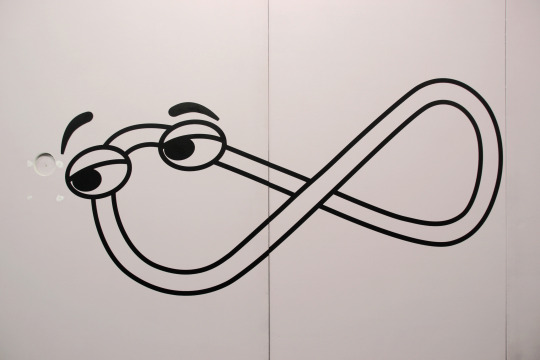

For this exhibition at the Window Space, Fàbregas has created a microclimate that causes condensation to form when temperatures drop. While this operation obscures the view from the street, it also has the paradoxical effect of making tangible the glass as a layer of mediation. Fàbregas intervention for the Window Space celebrates as well as multiplies these layers of mediation, inviting the audience to consider how indirect, devious, complex, and mannered is our access to the non-human world and its inhabitants.
How are you feeling today? was the third exhibition in the framework of the ‘Figures of Speech’ series introduced by Cristina Ramos. The project aims to use specific literary devices to contextualise its exhibitions, and will continue on various other locations after the Window Space.
(see below)
3 notes
·
View notes
